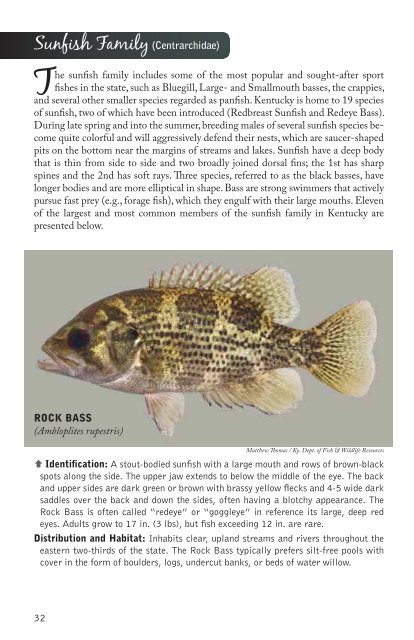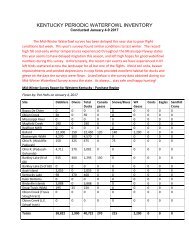Kentucky Fishes
kyfishid[1]
kyfishid[1]
- No tags were found...
You also want an ePaper? Increase the reach of your titles
YUMPU automatically turns print PDFs into web optimized ePapers that Google loves.
Sunfish Family (Centrarchidae)<br />
The sunfish family includes some of the most popular and sought-after sport<br />
fishes in the state, such as Bluegill, Large- and Smallmouth basses, the crappies,<br />
and several other smaller species regarded as panfish. <strong>Kentucky</strong> is home to 19 species<br />
of sunfish, two of which have been introduced (Redbreast Sunfish and Redeye Bass).<br />
During late spring and into the summer, breeding males of several sunfish species become<br />
quite colorful and will aggressively defend their nests, which are saucer-shaped<br />
pits on the bottom near the margins of streams and lakes. Sunfish have a deep body<br />
that is thin from side to side and two broadly joined dorsal fins; the 1st has sharp<br />
spines and the 2nd has soft rays. Three species, referred to as the black basses, have<br />
longer bodies and are more elliptical in shape. Bass are strong swimmers that actively<br />
pursue fast prey (e.g., forage fish), which they engulf with their large mouths. Eleven<br />
of the largest and most common members of the sunfish family in <strong>Kentucky</strong> are<br />
presented below.<br />
GREEN SUNFISH<br />
(Lepomis cyanellus)<br />
Matthew Thomas / Ky. Dept. of Fish & Wildlife Resources<br />
Ç Identification: A large, robust sunfish with a large mouth. The upper jaw extends<br />
to about the middle of the eye. A large black spot is present at the rear of the soft<br />
dorsal fin. The soft dorsal, anal, and caudal fins have yellow to orange margins.<br />
Pectoral fins are short and rounded. Adults can grow to 12 in. (2 lbs), but usually<br />
reach 8-10 in.<br />
Distribution and Habitat: Common statewide, inhabiting virtually all types of water<br />
bodies. The Green Sunfish is extremely adaptable and tolerant of extremes in turbidity,<br />
temperature, dissolved oxygen, and flow. It reaches greatest abundance in small<br />
sluggish streams and ponds, usually where few other sunfish occur.<br />
ROCK BASS<br />
(Ambloplites rupestris)<br />
Matthew Thomas / Ky. Dept. of Fish & Wildlife Resources<br />
Ç Identification: A stout-bodied sunfish with a large mouth and rows of brown-black<br />
spots along the side. The upper jaw extends to below the middle of the eye. The back<br />
and upper sides are dark green or brown with brassy yellow flecks and 4-5 wide dark<br />
saddles over the back and down the sides, often having a blotchy appearance. The<br />
Rock Bass is often called “redeye” or “goggleye” in reference its large, deep red<br />
eyes. Adults grow to 17 in. (3 lbs), but fish exceeding 12 in. are rare.<br />
Distribution and Habitat: Inhabits clear, upland streams and rivers throughout the<br />
eastern two-thirds of the state. The Rock Bass typically prefers silt-free pools with<br />
cover in the form of boulders, logs, undercut banks, or beds of water willow.<br />
WARMOUTH<br />
(Lepomis gulosus)<br />
Matthew Thomas / Ky. Dept. of Fish & Wildlife Resources<br />
Å Identification:<br />
A mediumsized,<br />
robust<br />
sunfish with<br />
a large head<br />
and mouth.<br />
The upper<br />
jaw extends<br />
to or beyond<br />
the middle<br />
of the eye.<br />
It is distinguished<br />
from<br />
other sunfish,<br />
including the Rock Bass, by having dark red-brown lines radiating from the back<br />
of the eye and a patch of small teeth on the tongue. Adults can grow to 12 in. (2.5<br />
lbs), but most fish are less than 10 in.<br />
Distribution and Habitat: Occurs throughout most of the state except for the Big<br />
Sandy River drainage in eastern <strong>Kentucky</strong>. The Warmouth is most common from the<br />
lower Green River westward. It is most often encountered in oxbow lakes, sloughs,<br />
wetlands, and reservoirs in clear, quiet water over soft bottoms and dense stands of<br />
aquatic vegetation.<br />
32 33



